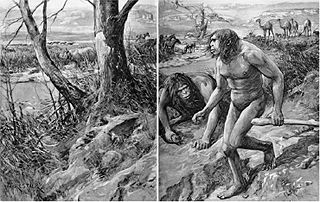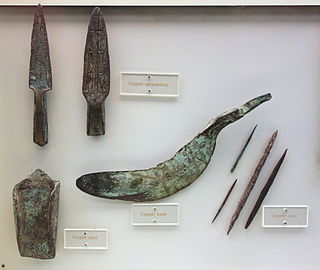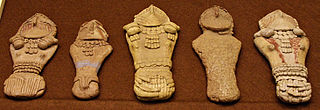 W
WThis is a list of Adena culture sites. The Adena culture was a Pre-Columbian Native American culture that existed from 1000 to 200 BCE, in a time known as the early Woodland Period. The Adena culture refers to what were probably a number of related Native American societies sharing a burial complex and ceremonial system. The Adena lived in a variety of locations, including: Ohio, Indiana, West Virginia, Kentucky, and parts of Pennsylvania and New York.
 W
WAncient Monuments of the Mississippi Valley (1848) by the Americans Ephraim George Squier and Edwin Hamilton Davis is a landmark in American scientific research, the study of the prehistoric indigenous mound builders of North America, and the early development of archaeology as a scientific discipline. Published in 1848, it was the Smithsonian Institution's first publication and the first volume in its Contributions to Knowledge series. The book had 306 pages, 48 lithographed maps and plates, and 207 wood engravings.
 W
WThe Archeological Society of Virginia is a non-profit organization that focuses on archaeological projects in Virginia for over 50 years. Members of the society have participated in hundreds of archeological excavations since its inception in 1940. They are made up of mostly amateur archaeologists, and they have strict policies against selling or purchasing artifacts. They publish a journal called the Quarterly Bulletin four times per year and maintain their headquarters at Kittiewan Plantation in Charles City County, VA.
 W
WThe Basketmaker culture of the pre-Ancestral Puebloans began about 1500 BC and continued until about AD 500 with the beginning of the Pueblo I Era. The prehistoric American southwestern culture was named "Basketmaker" for the large number of baskets found at archaeological sites of 3,000 to 2,000 years ago.
 W
WThe Clovis culture is a prehistoric Paleoamerican culture, named for distinct stone tools found in close association with Pleistocene fauna at Blackwater Locality No. 1 near Clovis, New Mexico in the 1920s and 1930s. It appears around 11,500–11,000 uncalibrated RCYBP at the end of the last glacial period, and is characterized by the manufacture of "Clovis points" and distinctive bone and ivory tools. Archaeologists' most precise determinations at present suggest this radiocarbon age is equal to roughly 13,200 to 12,900 calendar years ago. Clovis people are considered to be the ancestors of most of the indigenous peoples of the Americas.
 W
WThe Cody complex is a Paleo-Indian culture group first identified at a bison antiquus kill site near Cody, Wyoming in 1951. Points possessing characteristics of Cody Complex flaking have been found all across North America from Canada to as far south as Oklahoma and Texas.
 W
WThe Dalton Tradition is a Late Paleo-Indian and Early Archaic projectile point tradition. These points appeared in most of Southeast North America around 10,000–7,500 BC."They are distinctive artifacts, having concave bases with "ears" that sometimes flare outward ." ' These tools not only served as points but also as saws and knives. They were often changed in form and function because the hunters would sharpen the points over and over and would eventually turn them into knives then chisels or scrapers. A variant on the Dalton point is the Hardaway point of North Carolina.
 W
WDent Site is a Clovis culture site located in Weld County, Colorado, near Milliken, Colorado. It provided evidence that man and mammoth co-existed in the Americas.
 W
WThe Folsom Complex was a Paleo-Indian archaeological culture that occupied much of central North America. The term was first used in 1927 by Jesse Dade Figgins, director of the Colorado Museum of Natural History.
 W
WFort Ancient is a name for a Native American culture that flourished from Ca. 1000-1750 CE and predominantly inhabited land near the Ohio River valley in the areas of modern-day southern Ohio, northern Kentucky, southeastern Indiana and western West Virginia. Although a contemporary of the Mississippian Culture, they are often considered a "sister culture" and distinguished from the Mississippian Culture. Although far from agreed upon, there is evidence to suggest that the Fort Ancient Culture were not the direct descendants of the Hopewellian Culture. It is suspected that the Fort Ancient Culture introduced maize agriculture to Ohio. The Fort Ancient Culture were most likely the builders of the Great Serpent Mound.
 W
WThe Heartland model of Book of Mormon geography postulates that the events described in the Book of Mormon took place, primarily, in the heartland of North America.
 W
WThis is a list of sites and peoples visited by the Hernando de Soto Expedition in the years 1539–1543. In May 1539, de Soto left Havana, Cuba, with nine ships, over 620 men and 220 surviving horses and landed at Charlotte Harbor, Florida. This began his three-year odyssey through the Southeastern North American continent, from which de Soto and a large portion of his men would not return. They met many varied Native American groups, most of them bands and chiefdoms related to the widespread Mississippian culture. Only a few of these cultures survived into the seventeenth century. Others have been recorded only in the written historical accounts of de Soto's expedition.
 W
WThis is a list of Hopewell sites. The Hopewell tradition refers to the common aspects of the Native American culture that flourished along rivers in the northeastern and midwestern United States from 200 BCE to 500 CE. The Hopewell tradition was not a single culture or society, but a widely dispersed set of related populations that were connected by a common network of trade routes, known as the Hopewell Exchange System.
 W
WThis is a list of Mississippian sites. The Mississippian culture was a mound-building Native American culture that flourished in what is now the Midwestern, inland-Eastern, and Southeastern United States from approximately 800 CE to 1500 CE, varying regionally. Its core area, along the Mississippi River, stretched from sites such as Cahokia in modern Illinois, to Mound Bottom in Tennessee, to the Winterville site in the state of Mississippi. Temple mound complexes further extend from Aztalan in Wisconsin to Crystal River in Florida, and from Fort Ancient now in Ohio to Spiro in Oklahoma, while Mississippian cultural influences extended as far north and west, as modern North Dakota.
 W
WThe Monongahela culture were a Native American cultural manifestation of Late Woodland peoples from AD 1050 to 1635 in present-day western Pennsylvania, western Maryland, eastern Ohio, and West Virginia. The culture was named by Mary Butler in 1939 for the Monongahela River, whose valley contains the majority of this culture's sites.
 W
WA mound is a heaped pile of earth, gravel, sand, rocks, or debris. Most commonly, mounds are earthen formations such as hills and mountains, particularly if they appear artificial. A mound may be any rounded area of topographically higher elevation on any surface. Artificial mounds have been created for a variety of reasons throughout history, including ceremonial, burial (tumulus), and commemorative purposes.
 W
WThe Native American Graves Protection and Repatriation Act (NAGPRA), Pub. L. 101-601, 25 U.S.C. 3001 et seq., 104 Stat. 3048, is a United States federal law enacted on 16 November 1990.
 W
WNebraska Man was a name applied to Hesperopithecus haroldcookii, a putative species of ape. It was heralded as the first higher primate of North America. It was originally described by Henry Fairfield Osborn in 1922, on the basis of a tooth found by rancher and geologist Harold Cook in Nebraska in 1917. Although Nebraska man was not a deliberate hoax, the original classification proved to be a mistake, and was retracted in 1927.
 W
WNenana Valley is an archaeological site in the Yukon-Koyukuk Census Area of Alaska.
 W
WThe Norwood culture was a subculture or subperiod of the late Archaic culture.
 W
WOld Copper Complex or Old Copper Culture were ancient Native North American societies known to have extensively produced and used copper for weaponry and tools. The archeological evidence of smelting or alloying is subject to some dispute, and it is commonly believed that objects were cold-worked into shape. Artifacts from some of these sites have been dated from 4000 to 1000 BCE. Furthermore, some archaeologists are convinced by the artifactual and structural evidence for metal casting by Hopewellian and Mississippian peoples.
 W
WOneota is a designation archaeologists use to refer to a cultural complex that existed in the eastern plains and Great Lakes area of what is now occupied by the United States from around AD 900 to around 1650 or 1700. Based on classification defined in Gordon Willey and Philip Phillips' 1958 book Method and Theory in American Archaeology, the Oneota culture belongs to formative stage. The culture is believed to have transitioned into various Siouan cultures of the protohistoric and historic times, such as the Ioway. A long-accepted ancestry to the Ho-chunk has yet to be conclusively demonstrated.
 W
WA palisade, sometimes called a stakewall or a paling, is typically a fence or defensive wall made from iron or wooden stakes, or tree trunks, and used as a defensive structure or enclosure. Palisades can form a stockade.
 W
WPanhandle culture is a prehistoric culture of the southern High Plains during the Middle Ceramic Period from AD 1200 to 1400. Panhandle sites are primarily in the panhandle and west central Oklahoma and the northern half of the Texas Panhandle.
 W
WPicture Canyon, located in the Comanche National Grassland in southeastern Colorado, was named for its prehistoric rock art. There is evidence of prehistoric inhabitation of sites in Picture Canyon by Paleo-Indian, Archaic and Post-Archaic cultures, from about 12,000 years ago to 400 years ago. In addition to rock art, there are also carvings in walls that are used to identify the entry into fall and spring equinoxes.
 W
WThe Pilling Figurines are a set of eleven clay figurines made by the Fremont culture. They were discovered in 1950 by Clarence Pilling, a Utah rancher, under a rock overhang in a side canyon of Range Creek, Utah. The figurines are believed to be around 1000 years old.
 W
WThe Plano cultures is a name given by archaeologists to a group of disparate hunter-gatherer communities that occupied the Great Plains area of North America during the Paleo-Indian or Archaic period.
 W
WIn October 1932, while digging for gold in the San Pedro mountains, Carbon County, Wyoming, two prospectors, Cecil Mayne and Frank Carr, blasted their way through some thick rock that a large vein of gold continued into. When the dust settled, they saw they had opened up a small room, approximately 4 ft tall, 4 ft wide, and about 15 ft deep. This is where they said that they first saw the mummy of a tiny person.
 W
WShell rings are archaeological sites with curved shell middens completely or partially surrounding a clear space. The rings were sited next to estuaries that supported large populations of shellfish, usually oysters. Shell rings have been reported in several countries, including Colombia, Peru, Japan, and the southeastern United States. Archaeologists continue to debate the origins and use of shell rings.
 W
WShell works are large and complex assemblages of shell found in southwest Florida. Shell works include mounds and other deposits, with features described as borrow pits, canals, causeways, cisterns, crescents, sunken plazas, ponds, ramps, raised platforms, ridges, rings, walls, and "water courts". The largest shell works were constructed during the Woodland period in southwest Florida, from Charlotte Harbor to the Ten Thousand Islands, including Estero Bay.
 W
WThe Sinagua were a pre-Columbian culture that occupied a large area in central Arizona from the Little Colorado River, near Flagstaff, to the Verde River, near Sedona, including the Verde Valley, area around San Francisco Mountain, and significant portions of the Mogollon Rim country, between approximately 500 CE and 1425 CE.
 W
WThe Swift Creek culture was a Middle Woodland period archaeological culture in the Southeastern Woodlands of North America, dating to around 100-800 CE. It occupied the areas now part of Georgia, Alabama, Florida, South Carolina, and Tennessee. In Florida, Swift Creek ceremonial practices and burial complexes are referred to technically as the Yent-Green Point complex. The Swift Creek culture was contemporaneous with and interacted with the Hopewell culture; Swift Creek is often described as "Hopewellian." The type site for the Swift Creek culture was the Swift Creek mound site, which was located in Bibb County, Georgia. The Leake Mounds are another significant Swift Creek Culture site in Georgia.
 W
WThe Tennessee Division of Archaeology (TDOA) is a division of the Tennessee Department of Environment and Conservation responsible for managing prehistoric archaeological sites on lands owned by the U.S. state of Tennessee, conducting archaeological excavations and research, informing the public about Tennessee’s prehistoric past, and coordinating with other state agencies regarding archaeological preservation issues.
 W
WThe Twin Sisters are a pair of cannons used by Texas Military Forces during the Texas Revolution. They are among the most famous artillery in Texas military history with the "Come and Take It" cannon starting the revolution at the Battle of Gonzales and the Twin Sisters winning it at the Battle of San Jacinto. The Twin Sisters were also potentially used during the Mexican Invasions of 1842 and American Civil War.